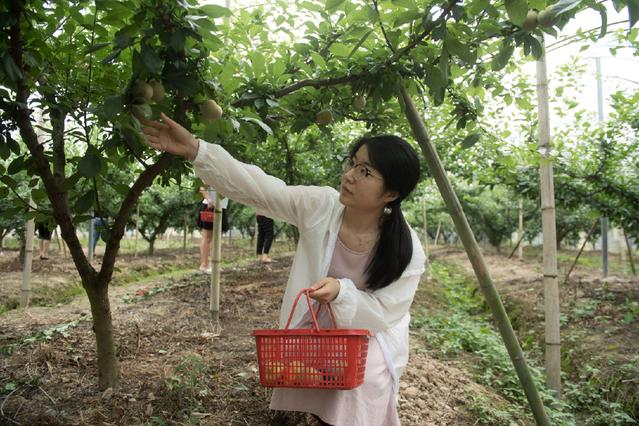

China has seen faster development of its rural tourism sector in recent years, offering travelers more programs and services.

A tourist picks fruits in an orchard in Shengzhou, east China’s Zhejiang province. (Photo/Xinhua)
Last year, the total number of trips to rural areas in China was 3.1 billion, up 9.7 percent year-on-year, accounting for more than half of the total domestic trips, and the total revenue of rural tourism was 1.8 trillion yuan, an increase of 11.3 percent year-on-year, according to monitoring data from the country’s Ministry of Culture and Tourism (MCT). Employees in the rural tourism sector accounted for 34.3 percent of the total number of employees at the sites monitored.
One typical example is Shimen Shanzhuang village in Qufu, east China’s Shandong province. As a national key village for rural tourism, it has vigorously developed rural tourism to boost rural vitalization, yielding fruitful results. Now the village receives over 400,000 tourists each year, with total revenue of 4 million yuan (about $595,717), which means an annual per capita net income of 11,000 yuan. It also creates jobs for more than 860 people each year.
China has also witnessed continuous improvement in the development quality of the sector. The MCT’s data show that 91.9 percent of the sites monitored set up waste collection points and the penetration rate of flush toilets reached 72.5 percent. Meanwhile, over 90 percent of rural tourism operators at the sites monitored had access to wireless networks.
So far, the country’s rural tourism has taken the lead in boosting the recovery of the tourism market amid the COVID-19 epidemic.
By the end of August, about 94.5 percent of the businesses in rural tourism had returned to operation, according to the MCT. In the second quarter, revenue from rural tourism increased by 148.8 percent month-on-month. The number of tourists and the total income of rural tourism in July and August basically reached the level of the same period last year.
Rural tourism has also offered visitors more products and services, including agritainment, unique natural sceneries, local conditions, folk customs, distinctive B&B hotels, parent-child trips, and nighttime tourism activities, to meet the diversified travel demand of the tourists.
To implement the country’s rural vitalization strategy and boost the further development of rural tourism, the MCT has recently made public a list of 680 key villages for promoting rural tourism.
The development of China’s tourism market and consumption upgrading means that the country’s rural tourism sector still has great potential to be tapped, said Wu Ruoshan, a researcher at the tourism research center of the Chinese Academy of Social Sciences.
The country should fully leverage natural and cultural resources in rural areas and combine local customs, fine traditional rural culture, and modern tourism needs to offer more products and services in the rural tourism market, unleashing new impetus for growth, Wu added.
 Fire brigade in Shanghai holds group wedding
Fire brigade in Shanghai holds group wedding Tourists enjoy ice sculptures in Datan Town, north China
Tourists enjoy ice sculptures in Datan Town, north China Sunset scenery of Dayan Pagoda in Xi'an
Sunset scenery of Dayan Pagoda in Xi'an Tourists have fun at scenic spot in Nanlong Town, NW China
Tourists have fun at scenic spot in Nanlong Town, NW China Harbin attracts tourists by making best use of ice in winter
Harbin attracts tourists by making best use of ice in winter In pics: FIS Alpine Ski Women's World Cup Slalom
In pics: FIS Alpine Ski Women's World Cup Slalom Black-necked cranes rest at reservoir in Lhunzhub County, Lhasa
Black-necked cranes rest at reservoir in Lhunzhub County, Lhasa China's FAST telescope will be available to foreign scientists in April
China's FAST telescope will be available to foreign scientists in April "She power" plays indispensable role in poverty alleviation
"She power" plays indispensable role in poverty alleviation Top 10 world news events of People's Daily in 2020
Top 10 world news events of People's Daily in 2020 Top 10 China news events of People's Daily in 2020
Top 10 China news events of People's Daily in 2020 Top 10 media buzzwords of 2020
Top 10 media buzzwords of 2020 Year-ender:10 major tourism stories of 2020
Year-ender:10 major tourism stories of 2020 No interference in Venezuelan issues
No interference in Venezuelan issues
 Biz prepares for trade spat
Biz prepares for trade spat
 Broadcasting Continent
Broadcasting Continent Australia wins Chinese CEOs as US loses
Australia wins Chinese CEOs as US loses